
Esztergom
Encyclopedia
Esztergom (ˈɛstɛrɡom,Estergon also known by alternative names), is a city
in northern Hungary
, 46 km north-west of the capital Budapest
. It lies in Komárom-Esztergom
county
, on the right bank of the river
Danube
, which forms the border with Slovakia
there.
Esztergom was the capital of Hungary from the 10th till the mid-13th century when King Béla IV of Hungary
moved the royal seat to Buda
.
Esztergom is the seat of the prímás (see Primate
) of the Roman Catholic Church
in Hungary. It's also the official seat of the Constitutional Court of Hungary
.
The city has the Keresztény Múzeum, the largest ecclesiastical collection in Hungary.
Its cathedral
, Esztergom Basilica
is the largest church in Hungary.
) and 'Gam' referring to the nearby river Garam). The Turkish and modern Slavic names are derived from the Hungarian one: Turkish Estergon, Croatian Ostrogon, Polish Ostrzyhom, Slovak Ostrihom and Czech Ostřihom (o is a familiar prefix in Slavic languages, and all-Slavic g is Czech and Slovak h). The German name is Gran , like the German name of river Garam,.
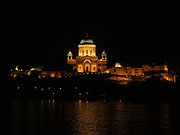
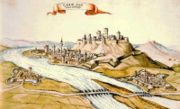
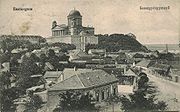

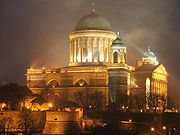


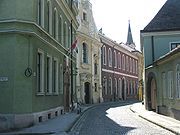
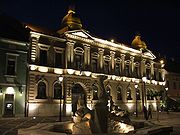
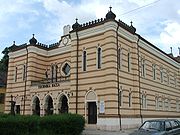
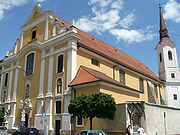
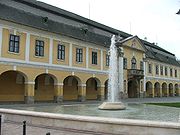

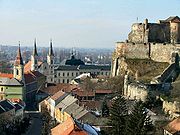
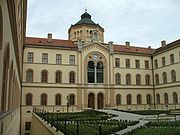
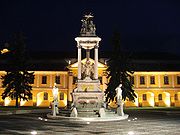
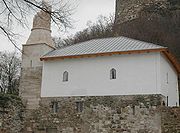
 Esztergom is one of the oldest towns in Hungary. Esztergom, as it existed in the Middle Ages
Esztergom is one of the oldest towns in Hungary. Esztergom, as it existed in the Middle Ages
, now rests under today's town The results of the most recent archeological excavations reveal that the Várhegy (Castle Hill) and its vicinity have been inhabited since the end of the Ice Age
20,000 years ago. The first people known by name were the Celts from Western Europe
, who settled in the region in about 350 BC. Under their centre on the Várhegy (oppidum) lay their expansive flourishing settlement until the Roman
legions conquered the region. Thereafter it became an important border province of Pannonia
, known by the name of Solva
. The German and Avar
archeological finds found in the area reveal that these people settled in the period of the migrations
that were caused by the fall of the Roman Empire
. Within the borders of the town, remains of its founding ancestors were found.
At about 500, Slavic peoples immigrated the Pannonia
n bassin. In ninth century, the place was part of Great Moravia
, afterwards of the Principality of Nitra
. In Old Slavonic
language, it was called Strěgom ("guard"), as it was a place to control Danube valley.
The Magyars entered Pannonian bassin in in 896, and conquered it systematically since 901. In 960, the ruling prince of the Hungarians, Géza
, chose Esztergom as his residence. His son, Vajk, who was later called Saint Stephen of Hungary, was born in his palace built on the Roman castrum on the Várhegy (Castle Hill) around 969-975. In 973, Esztergom served as the starting point of an important historical event. At Easter of that year Géza sent a committee to the international peace conference of Emperor Otto I in Quedlinburg
. He offered peace to the Emperor and asked for missionaries.
The prince's residence stood on the northern side of the hill. The center of the hill was occupied by a basilica
dedicated to St. Adalbert
, who, according to legend, baptised St. Stephen. The Church of St. Adalbert was the seat of the archbishop of Esztergom, the head of the Roman Catholic Church in Hungary.
By that time, significant craft and merchant settlements had been founded. (According to some scholars, the town got its name after Esztrogin, a Bulgar settlement of leather armour makers.)
In 1000, Stephen was crowned king in Esztergom. From the time of his rule up to the beginning of the 13th century, the only mint of the country operated here. At the same period the castle of Esztergom ( "Estergon Kalesi" in Turkish
) was built, which served not only as the royal residence until 1241 (the Mongol invasion) but also as the center of the Hungarian state, religion, and Esztergom county. The archbishop of Esztergom was the leader of the ten bishoprics founded by Stephen. The archbishop was often in charge of important state functions and had the exclusive right to crown kings.
The settlements of regal servants, merchants, craftsmen at the foot of the Várhegy (Castle Hill) developed into the most significant town of the age of the Árpád dynasty
– as being the most important scene of the economic life of the country. According to the Frenchman Odo de Deogilo, who visited the country in 1147, ‘…the Danube carries the economy and treasures of several countries to Esztergom’.
The town council was made up of the richest citizens of the town (residents of French
, Spanish
, Belgian, and Italian
origin) who dealt with commerce. The coat of arms of Esztergom emerged from their seal in the 13th century. This was the town where foreign monarchs could meet Hungarian kings. For example, Emperor Conrad II met Géza II in this town (1147). Another important meeting took place when the German Emperor Frederick Barbarossa
visited Béla III. The historians traveling with them all agree on the richness and significance of Esztergom. Arnold of Lübeck
, the historian with Frederick Barbarossa, called Esztergom the capital of Hungarian people ("quae Ungarorum est metropolis").
In the beginning of the 13th century Esztergom was the center of the country's political and economic life. This is explained by the canon of Nagyvárad, Rogerius of Apulia
, who witnessed the first devastation of the country during the Tatar invasion and wrote in his Carmen Miserabile
("Sad Song"): '...since there was no other town like Esztergom in Hungary, the Tatars
were considering crossing the Danube to pitch a camp there...', which was exactly what happened after the Danube froze. The capital of the Árpád-age was destroyed in a vicious battle. Though, according to the certificates that remained intact, some of the residents (those who escaped into the castle) survived and new residents settled in the area and soon started rebuilding the town, it lost its leading role. Béla IV gave the palace and castle to the archbishop, and changed his residence to Buda
. He himself and his family however, were buried in the Franciscan
church in Esztergom, which had been destroyed during the invasion, and which had been rebuilt by him in 1270.
Following these events, the castle was built and decorated by the bishops. The center of the king’s town however, which is surrounded by wall, was still of royal authority. A number of different monasteries did return or settle in the religious center.
Meanwhile the citizenry had been fighting for maintaining or reclaiming the rights of towns, against the expansion of the church within the regal town. In the chaotic years after the fall of the House of Árpád
, Esztergom suffered another calamity: in 1304, the forces of Wenceslaus II, the Czech
king occupied and raided the castle. In the years to come, the castle was owned by several individuals: Róbert Károly, and then Louis the Great patronized the town. In 1327, Kovácsi, the most influential suburb of the town, lying in the southeast, was united with Esztergom. The former suburb had three churches with mainly blacksmith, goldsmith, and coiner residents.
In the 14th and 15th centuries Esztergom saw events of great importance and became one of the most influential acropolis of Hungarian culture alongside with Buda
. Their courts, which were similar to the royal courts of Buda
and Visegrád
, were visited by such kings and scientists, artists as Louis the Great, Sigismund of Luxembourg, King Matthias Corvinus, Galeotto Marzio, Regiomontanus, the famous astronomer Márton Ilkus and Georg Peuerbach, Pier Paolo Vergerio
and Antonio Bonfini
, King Matthias’ historian, who, in his work praises the constructive work of János Vitéz, King Matthias’ educator. He had a library and an observatory built next to the cathedral. As Bonfini wrote about his masterpiece, his palace and terraced gardens: ‘… he had a spacious room for knights built in the castle. In front of that, he built a wonderful loggia
of red marble. In front of the room, he built the Chapel of Sybil
s, whose walls were decorated with paintings of the sybils. On the walls of the knights’ room, not only the likeness of all the kings could be found, but also the Scythian ancestors. He also had a double garden constructed, which was decorated with columns and a corridor above them. Between the two gardens, he built a round tower of red marble with several rooms and balconies. .. He had Saint Adalbert’s Basilica covered with glass tiles… ‘. King Matthias’ widow, Beatrix of Aragon, lived in the castle of Esztergom for ten years (1490–1500).
The time of the next resident, Archbishop Tamás Bakócz
(†l521) gave the town significant monuments. In 1507 he had Italian
architects build the Bakócz chapel, which is the earliest and most significant Renaissance
building which has survived in Hungary. The altarpiece of the chapel was carved from white marble by Andrea Ferrucci
, a sculptor from Fiesole
in 1519.
The Ottoman
conquest of Mohács
in 1526 brought a decline to the previously flourishing Esztergom as well. In the Battle of Mohács
, also the archbishop of Esztergom died. In the period between 1526 and 1543, when two rival kings reigned in Hungary, Esztergom was besieged six times. At times the forces of Ferdinand I
or John Zápolya, at other times the Ottomans attacked. Finally, in 1530, Ferdinand I occupied the castle. He put foreign mercenaries in the castle, and sent the chapter and the bishopric to Nagyszombat and Pozsony (that is why some of the treasury, the archives and the library survived.)
In 1543 Sultan Suleiman I attacked the castle
with an enormous army and countless cannons. Following two weeks of heroic struggle of resistance, the foreign (Spanish, Italian and German) guards betrayed the castle. This was the period when the outskirts were finally destroyed. The damaged buildings were not rebuilt any more. All means were used to rebuild and strengthen the fortresses or to build new ones. At the same time, the eastern section of the Saint Adalbert Church and other significant buildings of the castle were devastated.
Esztergom (Estergon) became the centre of an Ottoman sanjak
controlling several counties, and also a significant castle on the northwest border of the Ottoman Empire
– the main clashing point to prevent attacks on the mining towns of the highlands, Vienna
and Buda
. In 1594, during the unsuccessful but devastating siege by the walls of the Víziváros
, Bálint Balassa, the first Hungarian poet who gained European significance, died in action. The most devastating siege took place in 1595 when the castle was reclaimed by the troops of Count Karl von Mansfeld
and Count Mátyás Cseszneky
. The price that had to be paid, however, was high. Most of the buildings in the castle and the town that had been built in the Middle Ages
were destroyed during this period, and there were only uninhabitable, smothered ruins to welcome the liberators.
In 1605 the Ottomans regained control
over the castle as well as the whole region again, maintaining their rule until 1683. Though the Ottomans were mainly engaged in building and fortifying the castle, they also built significant new buildings including mosques, minarets and baths. These structures, along with the contemporary buildings, were destroyed in the siege of 1683
resulting in the liberation of Esztergom - though some Turkish buildings prevailed up to the beginning of the 18th century. The last time the Ottoman forces attacked Esztergom was in 1685
. During the following year Buda was liberated as well. During these battles did János Bottyán
, captain of the cavalry, later the legendary figure of the Rákóczi
war of independence disappear. All that had been rebuilt at the end of the century was destroyed and burnt down during Ferenc Rákóczi’s long lasting, but finally successful siege.
The destroyed territory was settled in by Hungarian, Slovakian and German settlers. This was when the new national landscape developed. In the area where there had previously been 65 Hungarian villages, only 22 were rebuilt. Though the reconstructed town received its free royal rights, its size and significance marked only the shadow of its old self.
Handicrafts gained strength and in around 1730, there were 17 independent crafts operating in Esztergom. Wine-culture was also of major significance. This was also the period when the Baroque
view of the downtown area and the Víziváros
(Watertown) were developed. The old town's main characteristic is the simplicity and moderateness of its citizen Baroque architecture. The most beautiful buildings can be found around the marketplace (Széchenyi square).
In 1761 the bishopric regained control over the castle, where they started the preliminary processes of the reconstruction of the new religious center: the middle of the Várhegy (Castle Hill), the remains of Saint Stephen and Saint Adalbert churches were carried away to provide room for the new cathedral.
Although the major construction work and the resettlement of the bishopric (1820) played a significant role in the town's life, the pace of Esztergom’s development gradually slowed down, and work on the new Basilica came to a halt.
By the beginning of the 20th century, Esztergom gained significance owing to its cultural and educational institutions as well as to being an administrative capital. The town’s situation turned worse after the Treaty of Trianon
of 1920, after which it became a border town and lost most of its previous territory.
This was also the place where the poet Mihály Babits
spent his summers from 1924 to his death in 1941. The poet's residence was one of the centers of the country's literary life; he had a significant effect on intellectual life in Esztergom.
Esztergom had one of the oldest Jewish communities in Hungary. They had a place of worship here by 1050. King Charles I
(Caroberto) gifted a plot to the community for a cemetery in 1326.
According to the 1910 census, 5.1% of the population were Jewish.
The 1941 census found 1510 Jews here. The community maintained an elementary school until 1944. Jewish shops were ordered to be closed on April 28, 1944, the short-lived ghetto was set up on May 11. The former Jewish shops were handed over to non-Jews on June 9. The inmates of the ghetto were sent to Komárom in early June, then deported to Auschwitz on June 16, 1944. Two forced labor units, whose members were mainly Esztergom Jews, were executed en masse near Ágfalva, on the Austrian border in January, 1945.
Soviet troops captured the town on December 26, 1944, but were pushed back by the Germans on January 6, 1945, who were finally ousted on March 21, 1945.
The Magyar Suzuki
Corporation plant opened in 1992, and is now the biggest employer in the city.
The Mária Valéria bridge
, connecting Esztergom with the city of Štúrovo
in Slovakia was rebuilt in 2001 with the support of the European Union
. Originally it was inaugurated in 1895, but the retreating German troops destroyed it in 1944. A new thermal and wellness spa opened in November, 2005.
period. This again put Esztergom in the center of attention. Following World War II
, Esztergom was left behind as one of the most severely devastated towns. However, reconstruction slowly managed to erase the traces of the war, with two of Esztergom’s most vital characteristics gaining significance: due to its situation it was the cultural center of the area (more than 8,000 students were educated at its elementary, secondary schools and college ). On the other hand, as a result of the local industrial development it has become a vital basis for the Hungarian tool and machinery industry.
Those traveling to Esztergom today can admire the most monumental construction of Hungarian Classicism, the Basilica, which silently rules the landscape above the winding Danube, surrounded by mountains.
The building that might be considered the symbol of the town is the largest church in Hungary and was built according the plans of Pál Kühnel, János Páckh and József Hild
from 1822 to 1869. Ferenc Liszt wrote the Mass of Esztergom for this occasion. The classicist church is enormous: the height of the dome
is 71,5 meters; it has giant arches and an enormous altar-piece by Michelangelo Grigoletti. On one side, in the Saint Stephen chapel, the glittering relics of Hungarian and other nations’ saints and valuable jewellery can be seen. On the south side, the Bakócz Chapel, the only one that survived the Middle Ages
, can be seen. The builders of the Basilica
had disassembled this structure into 1600 pieces, and incorporated it into the new church in its original form.
The treasury houses many masterpieces of medieval goldsmith's works. The western European masters’ hands are praised by such items as the crown silver cross that has been used since the 13th century, the ornate chalices, Francesco Francia’s processional cross, the upper part of the well-known ‘Matthias-Calvary’ which is decorated in the rare ronde-bosse
enamel
technique. The Treasury also has a vast collection of traditional Hungarian and European textiles, including chasubles, liturgical vestments and robes.
The sound of the enormous bell hung in the southern tower can be heard from kilometers away. From the top of the large dome, visitors can see a breath-taking view: to the north, east and south the ranges of the Börzsöny
, Visegrád
, Pilis
and Gerecse mountains rule the landscape, while to the west, in the valley of the Danube one can see as far as the Small Plains.
The winding streets of the town, with its church towers create a historical atmosphere. Below the Basilica, at the edge of the mountain stand the old walls, bastions and rondellas – the remains of the castle of Esztergom. The remains of one section of the royal palace and castle that had been built during the Ottoman rule had been buried in the ground up until the 1930s.
Most parts of the palace were explored and restored in the period between 1934 and 1938, but even today there are archeological excavations in progress. Passing through the narrow stairs, alleys, under arches and gates built in Romanesque
style, a part of the past seems to come to life. This part of the palace was built in the time of King Béla III. With his wife - the daughter of Louis VII
- French architects arrived and constructed the late-Roman and early-Gothic building at the end of the 12th century.
The frescoes of the palace chapel date from the 12th-14th centuries, while on the walls of the mottes, some of the most beautiful paintings of the early Hungarian Renaissance can be admired (15th c.). From the terrace of the palace one can admire the landscape of Esztergom. Under the terrace are the houses and churches of the Bishop-town section, or ‘Víziváros’ (Watertown) and the Primate's Palace. Opposite the palace is the Saint Thomas hill, and surrounded by the mountains and the Danube
. The walls of the castle still stand on the northern part of the Basilica. From the northern rondella one can admire the view of Párkány on the other side of the Danube as well as the Szentgyörgymező
, the Danube valley, and the So-called ‘Víziváros’ (Watertown) districts.
The Víziváros (Watertown) section was named after being built on the banks of the Kis- and Nagy Duna (Small and Great Danube
). Its fortresses, walls, bastions and Turkish
rondellas can still be seen by the walk on the banks of the Danube. By the northern end of the wall, on the bank of the Nagy-Duna, an interesting memorial is put, a stone table with Ottoman Turkish writings commemorates Sultan Suleiman
’s victorious siege of 1543. The narrow, winding streets within the walls hide the remains of Turkish mosque
s and baths.
Along the delightful streets of the Víziváros (Watertown), surrounded by Baroque
and Classicist buildings stands the Primate's Palace, designed by József Lippert (1880–82). The Keresztény Múzeum (Christian museum), founded by Archbishop János Simor, is located in this building. It houses a rich collection of Hungarian panel pictures and sculpture of the Middle Ages
as well as Italian and western-European paintings and handicrafts (13th-18th c.). This is where one can admire the chapel-like structure of the late Gothic
‘Úrkoporsó’ (Lord's coffin) from Garamszentbenedek that is decorated by painted wooden sculptures (c. 1480), the winged altar-piece by Thomas of Coloswar (1427), paintings by Master M.S. (1506), the gothic altars from Upper Historical Hungary (Felvidék), handicrafts of Italian, German and Flemish artists from the 13th–17th centuries, tapestries and ceramics.
The building of the Balassa Bálint Museum that was built in Baroque
style on medieval bases and is located in Víziváros (Watertown), served as the first town hall of Esztergom county after the Turks had been driven out of the region.
The parish-church in the centre of the Víziváros (Watertown), which was built by the Jesuits between 1728 and 1738, and the single-towered Franciscan
churches are also masterpieces of Baroque
architecture.
The Cathedral Library standing in the southern part of the town, which was built in 1853 according to plans by József Hild
is one of the richest religious libraries of Hungary, accommodating approximately 250,000 books, among which several codices and incunabula can be found, such as the Latin explanation of the ‘Song of Songs
’ from the 12th century, the ‘Lövöföldi Corvina’ originating from donations of King Matthias, or the Jordánszky-codex, which includes the Hungarian translation of the Bible from 1516-1519. Along with Bakócz and Ulászló gradual
s, they conserve also the Balassa Bible, in which Balassa’s uncle, Balassa András wrote down the circumstances of his birth and death.
The main sight of the nearby ‘Szent-Tamás hegy’ (Saint Thomas Hill) is the Baroque
Calvary, with the Classicist chapel on the top of the hill, which was built to commemorate the heroes who died for Esztergom. The hill was named after a church built by Bishop Lukács Bánffy in memoriam the martyr Saint Thomas Becket
, who had been his fellow student at the University of Paris. The church and the small castle which the Turks built there were destroyed a long time ago. On its original spot, the top of the hill, the narrow winding streets and small houses that were built by the masters who were working on the construction of the Basilica at the beginning of the previous century, have an atmosphere that is similar to that of Tabán
in Buda
. At the foot of the hill are the swimming pool and the Classicist building of the Fürdő Szálló (Bath Hotel). This is where Lajos Kossuth
stayed in 1848 on one of his recruiting tours.
On the southern slopes of the hill there is a Mediterranean, winding path with stairs that lead to the Baroque
Saint Stephen chapel. The main square of the town is the Széchényi square. Of the several buildings of Baroque
, Rococo
and Classicist style, there is one that catches everyone’s eyes: the Town Hall. Originally, it used to be the single-floor curia of Vak Bottyán (János Bottyán
, Bottyán the Blind), the Kuruc
general (1689). The first floor was constructed on its top in 1729. The house burnt down in the 1750s. It was rebuilt in accordance with the plans of a local architect, Antal Hartmann. Upon its façade there is a red marble carving which presents the coat of arms of Esztergom (a palace within the castle walls, protected by towers, with the Árpád
s’ shields below.)
On the corner of the building the equestrian statue of Vak Bottyán (created by István Martsa) commemorates the original owner of the house.
The Trinity-statue in the middle of the square was created by György Kiss in 1900. In Bottyán János Street, near the Town Hall, there are well decorated Baroque houses. This is where the Franciscan
church is located (built between 1700–1755). Opposite this building there is a Baroque palace which used to belong to the Sándor Earl family.
In the direction of the Kis Duna, the downtown parish-church, built by the architect Ignác Oratsek can be admired. A bit farther is the Classicist Church of Saint Anne. The orthodox
church at 60 Kossuth Lajos street was built around 1770 by Serbian
settlers in Esztergom.
This town, with its spectacular scenery and numerous memorials, a witness of the struggles of Hungarian history, is popular mostly with tourists interested in the beauties of the past and art. However, the town seems to regain its role in the country’s politics, and its buildings and traditions revive.
with:
Espoo
, Finland
, since 1974 Štúrovo
, Slovakia
, since 1991 Bamberg
, Germany
, since 1992 Cambrai
, France
, since 1992 Ehingen
, Germany
, since 1992 Maintal
, Germany
, since 1993 Gniezno
, Poland
, since 1994 Mariazell
, Austria
, since 2002 Canterbury
, United Kingdom
, since 2004
Partner City Szekszárd
, Hungary
since 2007
>
Year
Population
1880
14 944
1890
16 749
1893¹
15 749
1900
16 948
1910
17 881
1920
16 040
1930
17 354
1943
22 170
1949
20 040
>
Year
Population
1957
34 000
1967
26 000
1980
30 870
1990
28 730
2001
29 041
2006
30 122
¹ 9,349 living in the royal city
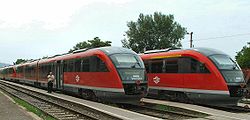
City
A city is a relatively large and permanent settlement. Although there is no agreement on how a city is distinguished from a town within general English language meanings, many cities have a particular administrative, legal, or historical status based on local law.For example, in the U.S...
in northern Hungary
Hungary
Hungary , officially the Republic of Hungary , is a landlocked country in Central Europe. It is situated in the Carpathian Basin and is bordered by Slovakia to the north, Ukraine and Romania to the east, Serbia and Croatia to the south, Slovenia to the southwest and Austria to the west. The...
, 46 km north-west of the capital Budapest
Budapest
Budapest is the capital of Hungary. As the largest city of Hungary, it is the country's principal political, cultural, commercial, industrial, and transportation centre. In 2011, Budapest had 1,733,685 inhabitants, down from its 1989 peak of 2,113,645 due to suburbanization. The Budapest Commuter...
. It lies in Komárom-Esztergom
Komárom-Esztergom
Komárom-Esztergom is an administrative Hungarian county in Transdanubia, on the northern border with Slovakia. It shares borders with the Hungarian counties of , , and...
county
County
A county is a jurisdiction of local government in certain modern nations. Historically in mainland Europe, the original French term, comté, and its equivalents in other languages denoted a jurisdiction under the sovereignty of a count A county is a jurisdiction of local government in certain...
, on the right bank of the river
River
A river is a natural watercourse, usually freshwater, flowing towards an ocean, a lake, a sea, or another river. In a few cases, a river simply flows into the ground or dries up completely before reaching another body of water. Small rivers may also be called by several other names, including...
Danube
Danube
The Danube is a river in the Central Europe and the Europe's second longest river after the Volga. It is classified as an international waterway....
, which forms the border with Slovakia
Slovakia
The Slovak Republic is a landlocked state in Central Europe. It has a population of over five million and an area of about . Slovakia is bordered by the Czech Republic and Austria to the west, Poland to the north, Ukraine to the east and Hungary to the south...
there.
Esztergom was the capital of Hungary from the 10th till the mid-13th century when King Béla IV of Hungary
Béla IV of Hungary
Béla IV , King of Hungary and of Croatia , duke of Styria 1254–58. One of the most famous kings of Hungary, he distinguished himself through his policy of strengthening of the royal power following the example of his grandfather Bela III, and by the rebuilding Hungary after the catastrophe of the...
moved the royal seat to Buda
Buda
For detailed information see: History of Buda CastleBuda is the western part of the Hungarian capital Budapest on the west bank of the Danube. The name Buda takes its name from the name of Bleda the Hun ruler, whose name is also Buda in Hungarian.Buda comprises about one-third of Budapest's...
.
Esztergom is the seat of the prímás (see Primate
Primate (religion)
Primate is a title or rank bestowed on some bishops in certain Christian churches. Depending on the particular tradition, it can denote either jurisdictional authority or ceremonial precedence ....
) of the Roman Catholic Church
Roman Catholic Church
The Catholic Church, also known as the Roman Catholic Church, is the world's largest Christian church, with over a billion members. Led by the Pope, it defines its mission as spreading the gospel of Jesus Christ, administering the sacraments and exercising charity...
in Hungary. It's also the official seat of the Constitutional Court of Hungary
Constitutional Court of Hungary
The Constitutional Court of Hungary is a special court of Hungary, making judicial review of the acts of the Parliament of Hungary. The official seat of the Constitutional Court is Esztergom....
.
The city has the Keresztény Múzeum, the largest ecclesiastical collection in Hungary.
Its cathedral
Cathedral
A cathedral is a Christian church that contains the seat of a bishop...
, Esztergom Basilica
Esztergom Basilica
The Primatial Basilica of the Blessed Virgin Mary Assumed Into Heaven and St Adalbert is an ecclesiastic basilica in Esztergom, Hungary, the mother church of the Archdiocese of Esztergom-Budapest, and the seat of the Catholic Church in Hungary...
is the largest church in Hungary.
Names
The Roman town was called Solva. The Old Slavonic name, Strěgom, is explained meaning guarding or guard post (rel. Czech střeh – watching position). This name was taken over by medieval Latin as Strigonium. The Madyars added a vowel in front of the initial group of consonants, similar to the Hungarian adaption of 'Stephan' as 'Istvan'. The name Esztergom was first mentioned in documents in 1079. Nevertheless, some people believe the name 'Esztergom' is a combination of 'Ister' (a Latin name of DanubeDanube
The Danube is a river in the Central Europe and the Europe's second longest river after the Volga. It is classified as an international waterway....
) and 'Gam' referring to the nearby river Garam). The Turkish and modern Slavic names are derived from the Hungarian one: Turkish Estergon, Croatian Ostrogon, Polish Ostrzyhom, Slovak Ostrihom and Czech Ostřihom (o is a familiar prefix in Slavic languages, and all-Slavic g is Czech and Slovak h). The German name is Gran , like the German name of river Garam,.
History


















Middle Ages
The Middle Ages is a periodization of European history from the 5th century to the 15th century. The Middle Ages follows the fall of the Western Roman Empire in 476 and precedes the Early Modern Era. It is the middle period of a three-period division of Western history: Classic, Medieval and Modern...
, now rests under today's town The results of the most recent archeological excavations reveal that the Várhegy (Castle Hill) and its vicinity have been inhabited since the end of the Ice Age
Ice age
An ice age or, more precisely, glacial age, is a generic geological period of long-term reduction in the temperature of the Earth's surface and atmosphere, resulting in the presence or expansion of continental ice sheets, polar ice sheets and alpine glaciers...
20,000 years ago. The first people known by name were the Celts from Western Europe
Western Europe
Western Europe is a loose term for the collection of countries in the western most region of the European continents, though this definition is context-dependent and carries cultural and political connotations. One definition describes Western Europe as a geographic entity—the region lying in the...
, who settled in the region in about 350 BC. Under their centre on the Várhegy (oppidum) lay their expansive flourishing settlement until the Roman
Ancient Rome
Ancient Rome was a thriving civilization that grew on the Italian Peninsula as early as the 8th century BC. Located along the Mediterranean Sea and centered on the city of Rome, it expanded to one of the largest empires in the ancient world....
legions conquered the region. Thereafter it became an important border province of Pannonia
Pannonia
Pannonia was an ancient province of the Roman Empire bounded north and east by the Danube, coterminous westward with Noricum and upper Italy, and southward with Dalmatia and upper Moesia....
, known by the name of Solva
Solva (Hungary)
Solva was an early name for what is now Esztergom, Hungary, in the province of Pannonia, during the Roman period. It was an important part of the Limes line along the Danube. Solva was granted town rank by Publius Aelius Hadrianus in 121 AD.-External links:...
. The German and Avar
Eurasian Avars
The Eurasian Avars or Ancient Avars were a highly organized nomadic confederacy of mixed origins. They were ruled by a khagan, who was surrounded by a tight-knit entourage of nomad warriors, an organization characteristic of Turko-Mongol groups...
archeological finds found in the area reveal that these people settled in the period of the migrations
Migration Period
The Migration Period, also called the Barbarian Invasions , was a period of intensified human migration in Europe that occurred from c. 400 to 800 CE. This period marked the transition from Late Antiquity to the Early Middle Ages...
that were caused by the fall of the Roman Empire
Roman Empire
The Roman Empire was the post-Republican period of the ancient Roman civilization, characterised by an autocratic form of government and large territorial holdings in Europe and around the Mediterranean....
. Within the borders of the town, remains of its founding ancestors were found.
At about 500, Slavic peoples immigrated the Pannonia
Pannonia
Pannonia was an ancient province of the Roman Empire bounded north and east by the Danube, coterminous westward with Noricum and upper Italy, and southward with Dalmatia and upper Moesia....
n bassin. In ninth century, the place was part of Great Moravia
Great Moravia
Great Moravia was a Slavic state that existed in Central Europe and lasted for nearly seventy years in the 9th century whose creators were the ancestors of the Czechs and Slovaks. It was a vassal state of the Germanic Frankish kingdom and paid an annual tribute to it. There is some controversy as...
, afterwards of the Principality of Nitra
Principality of Nitra
The Principality of Nitra also Nitrian Principality or Slovak Principality is the name for a polity of Nitra Sloviens, centered on large agglomeration, a multi-tribal centre around Nitra, Slovakia. The initially independent Principality of Nitra came into existence in the early 9th century...
. In Old Slavonic
Old Slavonic
Old Slavonic may refer to:*Old Church Slavonic language*Common Slavonic language...
language, it was called Strěgom ("guard"), as it was a place to control Danube valley.
The Magyars entered Pannonian bassin in in 896, and conquered it systematically since 901. In 960, the ruling prince of the Hungarians, Géza
Géza
Géza can refer to any of the following:* Géza of Hungary, Grand Prince of the Magyars* Géza I of Hungary, King of Hungary* Géza II of Hungary, King of Hungary...
, chose Esztergom as his residence. His son, Vajk, who was later called Saint Stephen of Hungary, was born in his palace built on the Roman castrum on the Várhegy (Castle Hill) around 969-975. In 973, Esztergom served as the starting point of an important historical event. At Easter of that year Géza sent a committee to the international peace conference of Emperor Otto I in Quedlinburg
Quedlinburg
Quedlinburg is a town located north of the Harz mountains, in the district of Harz in the west of Saxony-Anhalt, Germany. In 1994 the medieval court and the old town was set on the UNESCO world heritage list....
. He offered peace to the Emperor and asked for missionaries.
The prince's residence stood on the northern side of the hill. The center of the hill was occupied by a basilica
Basilica
The Latin word basilica , was originally used to describe a Roman public building, usually located in the forum of a Roman town. Public basilicas began to appear in Hellenistic cities in the 2nd century BC.The term was also applied to buildings used for religious purposes...
dedicated to St. Adalbert
Adalbert of Prague
This article is about St Adalbert of Prague. For other uses, see Adalbert .Saint Adalbert, Czech: ; , , Czech Roman Catholic saint, a Bishop of Prague and a missionary, was martyred in his efforts to convert the Baltic Prussians. He evangelized Poles and Hungarians. St...
, who, according to legend, baptised St. Stephen. The Church of St. Adalbert was the seat of the archbishop of Esztergom, the head of the Roman Catholic Church in Hungary.
By that time, significant craft and merchant settlements had been founded. (According to some scholars, the town got its name after Esztrogin, a Bulgar settlement of leather armour makers.)
In 1000, Stephen was crowned king in Esztergom. From the time of his rule up to the beginning of the 13th century, the only mint of the country operated here. At the same period the castle of Esztergom ( "Estergon Kalesi" in Turkish
Turkish language
Turkish is a language spoken as a native language by over 83 million people worldwide, making it the most commonly spoken of the Turkic languages. Its speakers are located predominantly in Turkey and Northern Cyprus with smaller groups in Iraq, Greece, Bulgaria, the Republic of Macedonia, Kosovo,...
) was built, which served not only as the royal residence until 1241 (the Mongol invasion) but also as the center of the Hungarian state, religion, and Esztergom county. The archbishop of Esztergom was the leader of the ten bishoprics founded by Stephen. The archbishop was often in charge of important state functions and had the exclusive right to crown kings.
The settlements of regal servants, merchants, craftsmen at the foot of the Várhegy (Castle Hill) developed into the most significant town of the age of the Árpád dynasty
Árpád dynasty
The Árpáds or Arpads was the ruling dynasty of the federation of the Hungarian tribes and of the Kingdom of Hungary . The dynasty was named after Grand Prince Árpád who was the head of the tribal federation when the Magyars occupied the Carpathian Basin, circa 895...
– as being the most important scene of the economic life of the country. According to the Frenchman Odo de Deogilo, who visited the country in 1147, ‘…the Danube carries the economy and treasures of several countries to Esztergom’.
The town council was made up of the richest citizens of the town (residents of French
French people
The French are a nation that share a common French culture and speak the French language as a mother tongue. Historically, the French population are descended from peoples of Celtic, Latin and Germanic origin, and are today a mixture of several ethnic groups...
, Spanish
Spanish people
The Spanish are citizens of the Kingdom of Spain. Within Spain, there are also a number of vigorous nationalisms and regionalisms, reflecting the country's complex history....
, Belgian, and Italian
Italian people
The Italian people are an ethnic group that share a common Italian culture, ancestry and speak the Italian language as a mother tongue. Within Italy, Italians are defined by citizenship, regardless of ancestry or country of residence , and are distinguished from people...
origin) who dealt with commerce. The coat of arms of Esztergom emerged from their seal in the 13th century. This was the town where foreign monarchs could meet Hungarian kings. For example, Emperor Conrad II met Géza II in this town (1147). Another important meeting took place when the German Emperor Frederick Barbarossa
Frederick I, Holy Roman Emperor
Frederick I Barbarossa was a German Holy Roman Emperor. He was elected King of Germany at Frankfurt on 4 March 1152 and crowned in Aachen on 9 March, crowned King of Italy in Pavia in 1155, and finally crowned Roman Emperor by Pope Adrian IV, on 18 June 1155, and two years later in 1157 the term...
visited Béla III. The historians traveling with them all agree on the richness and significance of Esztergom. Arnold of Lübeck
Arnold of Lübeck
Arnold of Lübeck was a Benedictine abbot, a chronicler, the author of the Chronica Slavorum.-References:...
, the historian with Frederick Barbarossa, called Esztergom the capital of Hungarian people ("quae Ungarorum est metropolis").
In the beginning of the 13th century Esztergom was the center of the country's political and economic life. This is explained by the canon of Nagyvárad, Rogerius of Apulia
Rogerius of Apulia
Rogerius of Apulia was a medieval Roman Catholic monk and chronicler, born in Torremaggiore, Apulia...
, who witnessed the first devastation of the country during the Tatar invasion and wrote in his Carmen Miserabile
Carmen Miserabile
Carmen Miserabile super Destructione Regni Hungariae per Tartaros is an account written by Rogerius of Apulia. After 1241, Rogerius wrote a description of the conquest of Transylvania and the Great Hungarian Plain by the Tatars in this work...
("Sad Song"): '...since there was no other town like Esztergom in Hungary, the Tatars
Tatars
Tatars are a Turkic speaking ethnic group , numbering roughly 7 million.The majority of Tatars live in the Russian Federation, with a population of around 5.5 million, about 2 million of which in the republic of Tatarstan.Significant minority populations are found in Uzbekistan, Kazakhstan,...
were considering crossing the Danube to pitch a camp there...', which was exactly what happened after the Danube froze. The capital of the Árpád-age was destroyed in a vicious battle. Though, according to the certificates that remained intact, some of the residents (those who escaped into the castle) survived and new residents settled in the area and soon started rebuilding the town, it lost its leading role. Béla IV gave the palace and castle to the archbishop, and changed his residence to Buda
Buda
For detailed information see: History of Buda CastleBuda is the western part of the Hungarian capital Budapest on the west bank of the Danube. The name Buda takes its name from the name of Bleda the Hun ruler, whose name is also Buda in Hungarian.Buda comprises about one-third of Budapest's...
. He himself and his family however, were buried in the Franciscan
Franciscan
Most Franciscans are members of Roman Catholic religious orders founded by Saint Francis of Assisi. Besides Roman Catholic communities, there are also Old Catholic, Anglican, Lutheran, ecumenical and Non-denominational Franciscan communities....
church in Esztergom, which had been destroyed during the invasion, and which had been rebuilt by him in 1270.
Following these events, the castle was built and decorated by the bishops. The center of the king’s town however, which is surrounded by wall, was still of royal authority. A number of different monasteries did return or settle in the religious center.
Meanwhile the citizenry had been fighting for maintaining or reclaiming the rights of towns, against the expansion of the church within the regal town. In the chaotic years after the fall of the House of Árpád
Árpád dynasty
The Árpáds or Arpads was the ruling dynasty of the federation of the Hungarian tribes and of the Kingdom of Hungary . The dynasty was named after Grand Prince Árpád who was the head of the tribal federation when the Magyars occupied the Carpathian Basin, circa 895...
, Esztergom suffered another calamity: in 1304, the forces of Wenceslaus II, the Czech
Czech people
Czechs, or Czech people are a western Slavic people of Central Europe, living predominantly in the Czech Republic. Small populations of Czechs also live in Slovakia, Austria, the United States, the United Kingdom, Chile, Argentina, Canada, Germany, Russia and other countries...
king occupied and raided the castle. In the years to come, the castle was owned by several individuals: Róbert Károly, and then Louis the Great patronized the town. In 1327, Kovácsi, the most influential suburb of the town, lying in the southeast, was united with Esztergom. The former suburb had three churches with mainly blacksmith, goldsmith, and coiner residents.
In the 14th and 15th centuries Esztergom saw events of great importance and became one of the most influential acropolis of Hungarian culture alongside with Buda
Buda
For detailed information see: History of Buda CastleBuda is the western part of the Hungarian capital Budapest on the west bank of the Danube. The name Buda takes its name from the name of Bleda the Hun ruler, whose name is also Buda in Hungarian.Buda comprises about one-third of Budapest's...
. Their courts, which were similar to the royal courts of Buda
Buda
For detailed information see: History of Buda CastleBuda is the western part of the Hungarian capital Budapest on the west bank of the Danube. The name Buda takes its name from the name of Bleda the Hun ruler, whose name is also Buda in Hungarian.Buda comprises about one-third of Budapest's...
and Visegrád
Visegrád
Visegrád is a small castle town in Pest County, Hungary.Situated north of Budapest on the right bank of the Danube in the Danube Bend, Visegrád has a population 1,654 as of 2001...
, were visited by such kings and scientists, artists as Louis the Great, Sigismund of Luxembourg, King Matthias Corvinus, Galeotto Marzio, Regiomontanus, the famous astronomer Márton Ilkus and Georg Peuerbach, Pier Paolo Vergerio
Pier Paolo Vergerio
Pier Paolo Vergerio was an Italian religious reformer.-Life:He was born at Capodistria , then part of the Venetian Republic and studied jurisprudence in Padua, where he delivered lectures in 1522. He also practiced law in Verona, Padua, and Venice...
and Antonio Bonfini
Antonio Bonfini
Antonio Bonfini was an Italian humanist and poet who spent the last years of his career as a court historian in Hungary with King Matthias Corvinus....
, King Matthias’ historian, who, in his work praises the constructive work of János Vitéz, King Matthias’ educator. He had a library and an observatory built next to the cathedral. As Bonfini wrote about his masterpiece, his palace and terraced gardens: ‘… he had a spacious room for knights built in the castle. In front of that, he built a wonderful loggia
Loggia
Loggia is the name given to an architectural feature, originally of Minoan design. They are often a gallery or corridor at ground level, sometimes higher, on the facade of a building and open to the air on one side, where it is supported by columns or pierced openings in the wall...
of red marble. In front of the room, he built the Chapel of Sybil
Sybil
In antiquity, the oracular seeresses of the Ancient Near East and the Mediterranean were referred to by the Greek term "sibyls". In modern times, when "Sibyl" is adopted for a woman's name, the conventional spelling is "Sybil".-People:...
s, whose walls were decorated with paintings of the sybils. On the walls of the knights’ room, not only the likeness of all the kings could be found, but also the Scythian ancestors. He also had a double garden constructed, which was decorated with columns and a corridor above them. Between the two gardens, he built a round tower of red marble with several rooms and balconies. .. He had Saint Adalbert’s Basilica covered with glass tiles… ‘. King Matthias’ widow, Beatrix of Aragon, lived in the castle of Esztergom for ten years (1490–1500).
The time of the next resident, Archbishop Tamás Bakócz
Tamás Bakócz
Tamás Bakócz was a Hungarian archbishop, cardinal and statesman.In sources in Croatian, Tamás Bakócz is also referred under the name Toma Bakač....
(†l521) gave the town significant monuments. In 1507 he had Italian
Italy
Italy , officially the Italian Republic languages]] under the European Charter for Regional or Minority Languages. In each of these, Italy's official name is as follows:;;;;;;;;), is a unitary parliamentary republic in South-Central Europe. To the north it borders France, Switzerland, Austria and...
architects build the Bakócz chapel, which is the earliest and most significant Renaissance
Renaissance
The Renaissance was a cultural movement that spanned roughly the 14th to the 17th century, beginning in Italy in the Late Middle Ages and later spreading to the rest of Europe. The term is also used more loosely to refer to the historical era, but since the changes of the Renaissance were not...
building which has survived in Hungary. The altarpiece of the chapel was carved from white marble by Andrea Ferrucci
Andrea Ferrucci
Andrea Ferrucci , also known as Andrea di Piero Ferruzzi and as Andrea da Fiesole, was an Italian sculptor who was born in Fiesole, Italy in 1465...
, a sculptor from Fiesole
Fiesole
Fiesole is a town and comune of the province of Florence in the Italian region of Tuscany, on a famously scenic height above Florence, 8 km NE of that city...
in 1519.
The Ottoman
Ottoman Empire
The Ottoman EmpireIt was usually referred to as the "Ottoman Empire", the "Turkish Empire", the "Ottoman Caliphate" or more commonly "Turkey" by its contemporaries...
conquest of Mohács
Mohács
Mohács is a town in Baranya county, Hungary on the right bank of the Danube.-History:Two famous battles took place there:# Battle of Mohács, 1526# Battle of Mohács, 1687...
in 1526 brought a decline to the previously flourishing Esztergom as well. In the Battle of Mohács
Battle of Mohács
The Battle of Mohács was fought on August 29, 1526 near Mohács, Hungary. In the battle, forces of the Kingdom of Hungary led by King Louis II of Hungary and Bohemia were defeated by forces of the Ottoman Empire led by Sultan Suleiman the Magnificent....
, also the archbishop of Esztergom died. In the period between 1526 and 1543, when two rival kings reigned in Hungary, Esztergom was besieged six times. At times the forces of Ferdinand I
Ferdinand I, Holy Roman Emperor
Ferdinand I was Holy Roman Emperor from 1558 and king of Bohemia and Hungary from 1526 until his death. Before his accession, he ruled the Austrian hereditary lands of the Habsburgs in the name of his elder brother, Charles V, Holy Roman Emperor.The key events during his reign were the contest...
or John Zápolya, at other times the Ottomans attacked. Finally, in 1530, Ferdinand I occupied the castle. He put foreign mercenaries in the castle, and sent the chapter and the bishopric to Nagyszombat and Pozsony (that is why some of the treasury, the archives and the library survived.)
In 1543 Sultan Suleiman I attacked the castle
Siege of Esztergom (1543)
The Siege of Esztergom occurred between 25 July and 10 August 1543, when the Ottoman emperor Suleyman the Magnificent besieged the city of Esztergom in modern Hungary. The city was captured by the Ottomans after two weeks.-Background:...
with an enormous army and countless cannons. Following two weeks of heroic struggle of resistance, the foreign (Spanish, Italian and German) guards betrayed the castle. This was the period when the outskirts were finally destroyed. The damaged buildings were not rebuilt any more. All means were used to rebuild and strengthen the fortresses or to build new ones. At the same time, the eastern section of the Saint Adalbert Church and other significant buildings of the castle were devastated.
Esztergom (Estergon) became the centre of an Ottoman sanjak
Sanjak
Sanjaks were administrative divisions of the Ottoman Empire. Sanjak, and the variant spellings sandjak, sanjaq, and sinjaq, are English transliterations of the Turkish word sancak, meaning district, banner, or flag...
controlling several counties, and also a significant castle on the northwest border of the Ottoman Empire
Ottoman Empire
The Ottoman EmpireIt was usually referred to as the "Ottoman Empire", the "Turkish Empire", the "Ottoman Caliphate" or more commonly "Turkey" by its contemporaries...
– the main clashing point to prevent attacks on the mining towns of the highlands, Vienna
Vienna
Vienna is the capital and largest city of the Republic of Austria and one of the nine states of Austria. Vienna is Austria's primary city, with a population of about 1.723 million , and is by far the largest city in Austria, as well as its cultural, economic, and political centre...
and Buda
Buda
For detailed information see: History of Buda CastleBuda is the western part of the Hungarian capital Budapest on the west bank of the Danube. The name Buda takes its name from the name of Bleda the Hun ruler, whose name is also Buda in Hungarian.Buda comprises about one-third of Budapest's...
. In 1594, during the unsuccessful but devastating siege by the walls of the Víziváros
Víziváros
Víziváros is a neighborhood of Esztergom, Hungary on the right bank of the Danube, under the royal castle and the St. Adalbert Primatial Basilica. The name Watertown derives from the numerous hot springs in the area.-History:...
, Bálint Balassa, the first Hungarian poet who gained European significance, died in action. The most devastating siege took place in 1595 when the castle was reclaimed by the troops of Count Karl von Mansfeld
Karl von Mansfeld
Karl von Mansfeld was a German general during the Cologne War and the Ottoman-Habsburg wars.Von Mansfeld was the son of Count Peter Ernst I von Mansfeld-Vorderort, born in present day Luxembourg, and was educated in France. He entered the military of Philip II of Spain, and was appointed a general...
and Count Mátyás Cseszneky
Mátyás Cseszneky
Count Mátyás Cseszneky de Milvány et Csesznek was a Hungarian magnate and cavalry commander.Mátyás Cseszneky was one of the bravest members of the Cseszneky family. He was a commander of a cavalry unit during the Long War and fought together with Miklós Pálffy, Ferenc Révay and Karl Mansfeld...
. The price that had to be paid, however, was high. Most of the buildings in the castle and the town that had been built in the Middle Ages
Middle Ages
The Middle Ages is a periodization of European history from the 5th century to the 15th century. The Middle Ages follows the fall of the Western Roman Empire in 476 and precedes the Early Modern Era. It is the middle period of a three-period division of Western history: Classic, Medieval and Modern...
were destroyed during this period, and there were only uninhabitable, smothered ruins to welcome the liberators.
In 1605 the Ottomans regained control
Long War (Ottoman wars)
The Long War took place from 1591 or 1593 to 1604 or 1606 and was one of the numerous military conflicts between the Habsburg Monarchy and the Ottoman Empire that developed after the Battle of Mohács.- History :The major participants of this war were the Habsburg Monarchy ,...
over the castle as well as the whole region again, maintaining their rule until 1683. Though the Ottomans were mainly engaged in building and fortifying the castle, they also built significant new buildings including mosques, minarets and baths. These structures, along with the contemporary buildings, were destroyed in the siege of 1683
Great Turkish War
The Great Turkish War refers to a series of conflicts between the Ottoman Empire and contemporary European powers, then joined into a Holy League, during the second half of the 17th century.-1667–1683:...
resulting in the liberation of Esztergom - though some Turkish buildings prevailed up to the beginning of the 18th century. The last time the Ottoman forces attacked Esztergom was in 1685
Great Turkish War
The Great Turkish War refers to a series of conflicts between the Ottoman Empire and contemporary European powers, then joined into a Holy League, during the second half of the 17th century.-1667–1683:...
. During the following year Buda was liberated as well. During these battles did János Bottyán
János Bottyán
János Bottyán , also known as Blind Bottyán, Vak Bottyán János was a Hungarian kuruc general....
, captain of the cavalry, later the legendary figure of the Rákóczi
Rákóczi
The Rákóczi were a Hungarian noble family in the Kingdom of Hungary between the 13th century and 18th century. Their name is also spelled Rakoczi and Rakoczy in some foreign sources....
war of independence disappear. All that had been rebuilt at the end of the century was destroyed and burnt down during Ferenc Rákóczi’s long lasting, but finally successful siege.
The destroyed territory was settled in by Hungarian, Slovakian and German settlers. This was when the new national landscape developed. In the area where there had previously been 65 Hungarian villages, only 22 were rebuilt. Though the reconstructed town received its free royal rights, its size and significance marked only the shadow of its old self.
Handicrafts gained strength and in around 1730, there were 17 independent crafts operating in Esztergom. Wine-culture was also of major significance. This was also the period when the Baroque
Baroque
The Baroque is a period and the style that used exaggerated motion and clear, easily interpreted detail to produce drama, tension, exuberance, and grandeur in sculpture, painting, literature, dance, and music...
view of the downtown area and the Víziváros
Víziváros
Víziváros is a neighborhood of Esztergom, Hungary on the right bank of the Danube, under the royal castle and the St. Adalbert Primatial Basilica. The name Watertown derives from the numerous hot springs in the area.-History:...
(Watertown) were developed. The old town's main characteristic is the simplicity and moderateness of its citizen Baroque architecture. The most beautiful buildings can be found around the marketplace (Széchenyi square).
In 1761 the bishopric regained control over the castle, where they started the preliminary processes of the reconstruction of the new religious center: the middle of the Várhegy (Castle Hill), the remains of Saint Stephen and Saint Adalbert churches were carried away to provide room for the new cathedral.
Although the major construction work and the resettlement of the bishopric (1820) played a significant role in the town's life, the pace of Esztergom’s development gradually slowed down, and work on the new Basilica came to a halt.
By the beginning of the 20th century, Esztergom gained significance owing to its cultural and educational institutions as well as to being an administrative capital. The town’s situation turned worse after the Treaty of Trianon
Treaty of Trianon
The Treaty of Trianon was the peace agreement signed in 1920, at the end of World War I, between the Allies of World War I and Hungary . The treaty greatly redefined and reduced Hungary's borders. From its borders before World War I, it lost 72% of its territory, which was reduced from to...
of 1920, after which it became a border town and lost most of its previous territory.
This was also the place where the poet Mihály Babits
Mihály Babits
Mihály Babits was a Hungarian poet, writer and translator.- Biography :...
spent his summers from 1924 to his death in 1941. The poet's residence was one of the centers of the country's literary life; he had a significant effect on intellectual life in Esztergom.
Esztergom had one of the oldest Jewish communities in Hungary. They had a place of worship here by 1050. King Charles I
Charles I of Hungary
Charles I , also known as Charles Robert , was the first King of Hungary and Croatia of the House of Anjou. He was also descended from the old Hungarian Árpád dynasty. His claim to the throne of Hungary was contested by several pretenders...
(Caroberto) gifted a plot to the community for a cemetery in 1326.
According to the 1910 census, 5.1% of the population were Jewish.
The 1941 census found 1510 Jews here. The community maintained an elementary school until 1944. Jewish shops were ordered to be closed on April 28, 1944, the short-lived ghetto was set up on May 11. The former Jewish shops were handed over to non-Jews on June 9. The inmates of the ghetto were sent to Komárom in early June, then deported to Auschwitz on June 16, 1944. Two forced labor units, whose members were mainly Esztergom Jews, were executed en masse near Ágfalva, on the Austrian border in January, 1945.
Soviet troops captured the town on December 26, 1944, but were pushed back by the Germans on January 6, 1945, who were finally ousted on March 21, 1945.
The Magyar Suzuki
Magyar Suzuki
Magyar Suzuki Corporation, located in Esztergom, Hungary, and founded in 1991, is a automobile manufacturing plant, a subsidiary of Suzuki.Through the end of September, 2005, the plant had a cumulative production volume of 849,000: 465,000 Suzuki Swift through March, 2003, 187,000 Suzuki Wagon R+,...
Corporation plant opened in 1992, and is now the biggest employer in the city.
The Mária Valéria bridge
Mária Valéria bridge
The Mária Valéria bridge joins Esztergom in Hungary and Štúrovo in Slovakia, across the River Danube. The bridge is some 500 metres in length...
, connecting Esztergom with the city of Štúrovo
Štúrovo
Štúrovo is a town in Slovakia, situated on the River Danube. Its population in 2005 was 11,172.The town is situated opposite the Hungarian city of Esztergom. The Mária Valéria bridge connects the settlements. The bridge was destroyed in 1944 during World War II, but reconstructed in...
in Slovakia was rebuilt in 2001 with the support of the European Union
European Union
The European Union is an economic and political union of 27 independent member states which are located primarily in Europe. The EU traces its origins from the European Coal and Steel Community and the European Economic Community , formed by six countries in 1958...
. Originally it was inaugurated in 1895, but the retreating German troops destroyed it in 1944. A new thermal and wellness spa opened in November, 2005.
Architecture
One of the most important events of the 1930s was the exploration and renovation of the remains of the palace of the ÁrpádÁrpád
Árpád was the second Grand Prince of the Hungarians . Under his rule the Hungarian people settled in the Carpathian basin. The dynasty descending from him ruled the Hungarian tribes and later the Kingdom of Hungary until 1301...
period. This again put Esztergom in the center of attention. Following World War II
World War II
World War II, or the Second World War , was a global conflict lasting from 1939 to 1945, involving most of the world's nations—including all of the great powers—eventually forming two opposing military alliances: the Allies and the Axis...
, Esztergom was left behind as one of the most severely devastated towns. However, reconstruction slowly managed to erase the traces of the war, with two of Esztergom’s most vital characteristics gaining significance: due to its situation it was the cultural center of the area (more than 8,000 students were educated at its elementary, secondary schools and college ). On the other hand, as a result of the local industrial development it has become a vital basis for the Hungarian tool and machinery industry.
Those traveling to Esztergom today can admire the most monumental construction of Hungarian Classicism, the Basilica, which silently rules the landscape above the winding Danube, surrounded by mountains.
The building that might be considered the symbol of the town is the largest church in Hungary and was built according the plans of Pál Kühnel, János Páckh and József Hild
József Hild
József Hild was a Hungarian architect. One of the major exponents of neoclassical architecture of the time, he played an important part in the remodelling of Pest during the so-called reform era .- Life and career :...
from 1822 to 1869. Ferenc Liszt wrote the Mass of Esztergom for this occasion. The classicist church is enormous: the height of the dome
Dome
A dome is a structural element of architecture that resembles the hollow upper half of a sphere. Dome structures made of various materials have a long architectural lineage extending into prehistory....
is 71,5 meters; it has giant arches and an enormous altar-piece by Michelangelo Grigoletti. On one side, in the Saint Stephen chapel, the glittering relics of Hungarian and other nations’ saints and valuable jewellery can be seen. On the south side, the Bakócz Chapel, the only one that survived the Middle Ages
Middle Ages
The Middle Ages is a periodization of European history from the 5th century to the 15th century. The Middle Ages follows the fall of the Western Roman Empire in 476 and precedes the Early Modern Era. It is the middle period of a three-period division of Western history: Classic, Medieval and Modern...
, can be seen. The builders of the Basilica
Basilica
The Latin word basilica , was originally used to describe a Roman public building, usually located in the forum of a Roman town. Public basilicas began to appear in Hellenistic cities in the 2nd century BC.The term was also applied to buildings used for religious purposes...
had disassembled this structure into 1600 pieces, and incorporated it into the new church in its original form.
The treasury houses many masterpieces of medieval goldsmith's works. The western European masters’ hands are praised by such items as the crown silver cross that has been used since the 13th century, the ornate chalices, Francesco Francia’s processional cross, the upper part of the well-known ‘Matthias-Calvary’ which is decorated in the rare ronde-bosse
Ronde-bosse
Ronde-bosse, en ronde bosse or encrusted enamel is an enamelling technique developed in France in the late 14th century that produces small three-dimensional figures, or reliefs, largely or entirely covered in enamel. The new method involved the partial concealment of the underlying gold, or...
enamel
Vitreous enamel
Vitreous enamel, also porcelain enamel in U.S. English, is a material made by fusing powdered glass to a substrate by firing, usually between 750 and 850 °C...
technique. The Treasury also has a vast collection of traditional Hungarian and European textiles, including chasubles, liturgical vestments and robes.
The sound of the enormous bell hung in the southern tower can be heard from kilometers away. From the top of the large dome, visitors can see a breath-taking view: to the north, east and south the ranges of the Börzsöny
Börzsöny
Börzsöny is a mountain range in Northern Hungary. Its tallest peak is the Csóványos with 938 metres.It is the westernmost member of the North Hungarian Mountains, which in turn are part of the Inner Western Carpathians. The varied landscape offers good hiking opportunities. A large part of the...
, Visegrád
Visegrád
Visegrád is a small castle town in Pest County, Hungary.Situated north of Budapest on the right bank of the Danube in the Danube Bend, Visegrád has a population 1,654 as of 2001...
, Pilis
Pilis
-History:It was inhabited in the prehistoric times, but later it was abandoned at the end of the Roman rule. The town was then first mentioned in 1326. It was destroyed during the ottoman rule in the 16th century, and was reestablished only in 1711, by János Beleznay, the local landlord. He brought...
and Gerecse mountains rule the landscape, while to the west, in the valley of the Danube one can see as far as the Small Plains.
The winding streets of the town, with its church towers create a historical atmosphere. Below the Basilica, at the edge of the mountain stand the old walls, bastions and rondellas – the remains of the castle of Esztergom. The remains of one section of the royal palace and castle that had been built during the Ottoman rule had been buried in the ground up until the 1930s.
Most parts of the palace were explored and restored in the period between 1934 and 1938, but even today there are archeological excavations in progress. Passing through the narrow stairs, alleys, under arches and gates built in Romanesque
Romanesque architecture
Romanesque architecture is an architectural style of Medieval Europe characterised by semi-circular arches. There is no consensus for the beginning date of the Romanesque architecture, with proposals ranging from the 6th to the 10th century. It developed in the 12th century into the Gothic style,...
style, a part of the past seems to come to life. This part of the palace was built in the time of King Béla III. With his wife - the daughter of Louis VII
Louis VII of France
Louis VII was King of France, the son and successor of Louis VI . He ruled from 1137 until his death. He was a member of the House of Capet. His reign was dominated by feudal struggles , and saw the beginning of the long rivalry between France and England...
- French architects arrived and constructed the late-Roman and early-Gothic building at the end of the 12th century.
The frescoes of the palace chapel date from the 12th-14th centuries, while on the walls of the mottes, some of the most beautiful paintings of the early Hungarian Renaissance can be admired (15th c.). From the terrace of the palace one can admire the landscape of Esztergom. Under the terrace are the houses and churches of the Bishop-town section, or ‘Víziváros’ (Watertown) and the Primate's Palace. Opposite the palace is the Saint Thomas hill, and surrounded by the mountains and the Danube
Danube
The Danube is a river in the Central Europe and the Europe's second longest river after the Volga. It is classified as an international waterway....
. The walls of the castle still stand on the northern part of the Basilica. From the northern rondella one can admire the view of Párkány on the other side of the Danube as well as the Szentgyörgymező
Szentgyörgymezo
Szentgyörgymező is the northern part of the city of Esztergom in Hungary, on the right bank of the river Danube. It was a separate village until 1895, when it was merged with the "Royal Esztergom" as 4th district, along with neighboring Víziváros and Szenttamás...
, the Danube valley, and the So-called ‘Víziváros’ (Watertown) districts.
The Víziváros (Watertown) section was named after being built on the banks of the Kis- and Nagy Duna (Small and Great Danube
Danube
The Danube is a river in the Central Europe and the Europe's second longest river after the Volga. It is classified as an international waterway....
). Its fortresses, walls, bastions and Turkish
Ottoman Empire
The Ottoman EmpireIt was usually referred to as the "Ottoman Empire", the "Turkish Empire", the "Ottoman Caliphate" or more commonly "Turkey" by its contemporaries...
rondellas can still be seen by the walk on the banks of the Danube. By the northern end of the wall, on the bank of the Nagy-Duna, an interesting memorial is put, a stone table with Ottoman Turkish writings commemorates Sultan Suleiman
Suleiman
Suleiman is the main transliteration of the Arabic name, , the name means "man of peace" and corresponds to the English name Solomon.The word may also be transliterated as Sulaiman, Suleman, Soliman, Sulayman, Süleyman, Sulejman, Sleiman, Sleman, Solyman or Seleman...
’s victorious siege of 1543. The narrow, winding streets within the walls hide the remains of Turkish mosque
Mosque
A mosque is a place of worship for followers of Islam. The word is likely to have entered the English language through French , from Portuguese , from Spanish , and from Berber , ultimately originating in — . The Arabic word masjid literally means a place of prostration...
s and baths.
Along the delightful streets of the Víziváros (Watertown), surrounded by Baroque
Baroque
The Baroque is a period and the style that used exaggerated motion and clear, easily interpreted detail to produce drama, tension, exuberance, and grandeur in sculpture, painting, literature, dance, and music...
and Classicist buildings stands the Primate's Palace, designed by József Lippert (1880–82). The Keresztény Múzeum (Christian museum), founded by Archbishop János Simor, is located in this building. It houses a rich collection of Hungarian panel pictures and sculpture of the Middle Ages
Middle Ages
The Middle Ages is a periodization of European history from the 5th century to the 15th century. The Middle Ages follows the fall of the Western Roman Empire in 476 and precedes the Early Modern Era. It is the middle period of a three-period division of Western history: Classic, Medieval and Modern...
as well as Italian and western-European paintings and handicrafts (13th-18th c.). This is where one can admire the chapel-like structure of the late Gothic
Gothic architecture
Gothic architecture is a style of architecture that flourished during the high and late medieval period. It evolved from Romanesque architecture and was succeeded by Renaissance architecture....
‘Úrkoporsó’ (Lord's coffin) from Garamszentbenedek that is decorated by painted wooden sculptures (c. 1480), the winged altar-piece by Thomas of Coloswar (1427), paintings by Master M.S. (1506), the gothic altars from Upper Historical Hungary (Felvidék), handicrafts of Italian, German and Flemish artists from the 13th–17th centuries, tapestries and ceramics.
The building of the Balassa Bálint Museum that was built in Baroque
Baroque
The Baroque is a period and the style that used exaggerated motion and clear, easily interpreted detail to produce drama, tension, exuberance, and grandeur in sculpture, painting, literature, dance, and music...
style on medieval bases and is located in Víziváros (Watertown), served as the first town hall of Esztergom county after the Turks had been driven out of the region.
The parish-church in the centre of the Víziváros (Watertown), which was built by the Jesuits between 1728 and 1738, and the single-towered Franciscan
Franciscan
Most Franciscans are members of Roman Catholic religious orders founded by Saint Francis of Assisi. Besides Roman Catholic communities, there are also Old Catholic, Anglican, Lutheran, ecumenical and Non-denominational Franciscan communities....
churches are also masterpieces of Baroque
Baroque
The Baroque is a period and the style that used exaggerated motion and clear, easily interpreted detail to produce drama, tension, exuberance, and grandeur in sculpture, painting, literature, dance, and music...
architecture.
The Cathedral Library standing in the southern part of the town, which was built in 1853 according to plans by József Hild
József Hild
József Hild was a Hungarian architect. One of the major exponents of neoclassical architecture of the time, he played an important part in the remodelling of Pest during the so-called reform era .- Life and career :...
is one of the richest religious libraries of Hungary, accommodating approximately 250,000 books, among which several codices and incunabula can be found, such as the Latin explanation of the ‘Song of Songs
Song of songs
Song of Songs, also known as the Song of Solomon, is a book of the Hebrew Bible or Old Testament. It may also refer to:In music:* Song of songs , the debut album by David and the Giants* A generic term for medleysPlays...
’ from the 12th century, the ‘Lövöföldi Corvina’ originating from donations of King Matthias, or the Jordánszky-codex, which includes the Hungarian translation of the Bible from 1516-1519. Along with Bakócz and Ulászló gradual
Gradual
The Gradual is a chant or hymn in the liturgical celebration of the Eucharist for many Christian denominations. In the Tridentine Mass it was and is sung after the reading or chanting of the Epistle and before the Alleluia, or, during penitential seasons, before the Tract. In the Mass of Paul VI...
s, they conserve also the Balassa Bible, in which Balassa’s uncle, Balassa András wrote down the circumstances of his birth and death.
The main sight of the nearby ‘Szent-Tamás hegy’ (Saint Thomas Hill) is the Baroque
Baroque
The Baroque is a period and the style that used exaggerated motion and clear, easily interpreted detail to produce drama, tension, exuberance, and grandeur in sculpture, painting, literature, dance, and music...
Calvary, with the Classicist chapel on the top of the hill, which was built to commemorate the heroes who died for Esztergom. The hill was named after a church built by Bishop Lukács Bánffy in memoriam the martyr Saint Thomas Becket
Thomas Becket
Thomas Becket was Archbishop of Canterbury from 1162 until his murder in 1170. He is venerated as a saint and martyr by both the Roman Catholic Church and the Anglican Communion...
, who had been his fellow student at the University of Paris. The church and the small castle which the Turks built there were destroyed a long time ago. On its original spot, the top of the hill, the narrow winding streets and small houses that were built by the masters who were working on the construction of the Basilica at the beginning of the previous century, have an atmosphere that is similar to that of Tabán
Tabán
Tabán usually refers to an area within the 1st district of Budapest, the capital of Hungary. It lies on the Buda side of the Danube, to the south of György Dózsa Square, on the northern side of Elisabeth Bridge and to the east of Naphegy...
in Buda
Buda
For detailed information see: History of Buda CastleBuda is the western part of the Hungarian capital Budapest on the west bank of the Danube. The name Buda takes its name from the name of Bleda the Hun ruler, whose name is also Buda in Hungarian.Buda comprises about one-third of Budapest's...
. At the foot of the hill are the swimming pool and the Classicist building of the Fürdő Szálló (Bath Hotel). This is where Lajos Kossuth
Lajos Kossuth
Lajos Kossuth de Udvard et Kossuthfalva was a Hungarian lawyer, journalist, politician and Regent-President of Hungary in 1849. He was widely honored during his lifetime, including in the United Kingdom and the United States, as a freedom fighter and bellwether of democracy in Europe.-Family:Lajos...
stayed in 1848 on one of his recruiting tours.
On the southern slopes of the hill there is a Mediterranean, winding path with stairs that lead to the Baroque
Baroque
The Baroque is a period and the style that used exaggerated motion and clear, easily interpreted detail to produce drama, tension, exuberance, and grandeur in sculpture, painting, literature, dance, and music...
Saint Stephen chapel. The main square of the town is the Széchényi square. Of the several buildings of Baroque
Baroque
The Baroque is a period and the style that used exaggerated motion and clear, easily interpreted detail to produce drama, tension, exuberance, and grandeur in sculpture, painting, literature, dance, and music...
, Rococo
Rococo
Rococo , also referred to as "Late Baroque", is an 18th-century style which developed as Baroque artists gave up their symmetry and became increasingly ornate, florid, and playful...
and Classicist style, there is one that catches everyone’s eyes: the Town Hall. Originally, it used to be the single-floor curia of Vak Bottyán (János Bottyán
János Bottyán
János Bottyán , also known as Blind Bottyán, Vak Bottyán János was a Hungarian kuruc general....
, Bottyán the Blind), the Kuruc
Kuruc
The kuruc was a term used to denote the armed anti-Habsburg rebels in Royal Hungary between 1671 and 1711....
general (1689). The first floor was constructed on its top in 1729. The house burnt down in the 1750s. It was rebuilt in accordance with the plans of a local architect, Antal Hartmann. Upon its façade there is a red marble carving which presents the coat of arms of Esztergom (a palace within the castle walls, protected by towers, with the Árpád
Árpád
Árpád was the second Grand Prince of the Hungarians . Under his rule the Hungarian people settled in the Carpathian basin. The dynasty descending from him ruled the Hungarian tribes and later the Kingdom of Hungary until 1301...
s’ shields below.)
On the corner of the building the equestrian statue of Vak Bottyán (created by István Martsa) commemorates the original owner of the house.
The Trinity-statue in the middle of the square was created by György Kiss in 1900. In Bottyán János Street, near the Town Hall, there are well decorated Baroque houses. This is where the Franciscan
Franciscan
Most Franciscans are members of Roman Catholic religious orders founded by Saint Francis of Assisi. Besides Roman Catholic communities, there are also Old Catholic, Anglican, Lutheran, ecumenical and Non-denominational Franciscan communities....
church is located (built between 1700–1755). Opposite this building there is a Baroque palace which used to belong to the Sándor Earl family.
In the direction of the Kis Duna, the downtown parish-church, built by the architect Ignác Oratsek can be admired. A bit farther is the Classicist Church of Saint Anne. The orthodox
Eastern Orthodox Church
The Orthodox Church, officially called the Orthodox Catholic Church and commonly referred to as the Eastern Orthodox Church, is the second largest Christian denomination in the world, with an estimated 300 million adherents mainly in the countries of Belarus, Bulgaria, Cyprus, Georgia, Greece,...
church at 60 Kossuth Lajos street was built around 1770 by Serbian
Serbs
The Serbs are a South Slavic ethnic group of the Balkans and southern Central Europe. Serbs are located mainly in Serbia, Montenegro and Bosnia and Herzegovina, and form a sizable minority in Croatia, the Republic of Macedonia and Slovenia. Likewise, Serbs are an officially recognized minority in...
settlers in Esztergom.
This town, with its spectacular scenery and numerous memorials, a witness of the struggles of Hungarian history, is popular mostly with tourists interested in the beauties of the past and art. However, the town seems to regain its role in the country’s politics, and its buildings and traditions revive.
Twin towns — Sister cities
Esztergom is twinnedTown twinning
Twin towns and sister cities are two of many terms used to describe the cooperative agreements between towns, cities, and even counties in geographically and politically distinct areas to promote cultural and commercial ties.- Terminology :...
with:
Espoo
Espoo
Espoo is the second largest city and municipality in Finland. The population of the city of Espoo is . It is part of the Helsinki Metropolitan Area along with the cities of Helsinki, Vantaa, and Kauniainen. Espoo shares its eastern border with Helsinki and Vantaa, while enclosing Kauniainen....
, Finland
Finland
Finland , officially the Republic of Finland, is a Nordic country situated in the Fennoscandian region of Northern Europe. It is bordered by Sweden in the west, Norway in the north and Russia in the east, while Estonia lies to its south across the Gulf of Finland.Around 5.4 million people reside...
, since 1974 Štúrovo
Štúrovo
Štúrovo is a town in Slovakia, situated on the River Danube. Its population in 2005 was 11,172.The town is situated opposite the Hungarian city of Esztergom. The Mária Valéria bridge connects the settlements. The bridge was destroyed in 1944 during World War II, but reconstructed in...
, Slovakia
Slovakia
The Slovak Republic is a landlocked state in Central Europe. It has a population of over five million and an area of about . Slovakia is bordered by the Czech Republic and Austria to the west, Poland to the north, Ukraine to the east and Hungary to the south...
, since 1991 Bamberg
Bamberg
Bamberg is a city in Bavaria, Germany. It is located in Upper Franconia on the river Regnitz, close to its confluence with the river Main. Bamberg is one of the few cities in Germany that was not destroyed by World War II bombings because of a nearby Artillery Factory that prevented planes from...
, Germany
Germany
Germany , officially the Federal Republic of Germany , is a federal parliamentary republic in Europe. The country consists of 16 states while the capital and largest city is Berlin. Germany covers an area of 357,021 km2 and has a largely temperate seasonal climate...
, since 1992 Cambrai
Cambrai
Cambrai is a commune in the Nord department in northern France. It is a sub-prefecture of the department.Cambrai is the seat of an archdiocese whose jurisdiction was immense during the Middle Ages. The territory of the Bishopric of Cambrai, roughly coinciding with the shire of Brabant, included...
, France
France
The French Republic , The French Republic , The French Republic , (commonly known as France , is a unitary semi-presidential republic in Western Europe with several overseas territories and islands located on other continents and in the Indian, Pacific, and Atlantic oceans. Metropolitan France...
, since 1992 Ehingen
Ehingen
Ehingen is a town in the Alb-Donau district in Baden-Württemberg, Germany, situated on the left bank of the Danube, approx. 25 km southwest of Ulm and 67 km southeast of Stuttgart.-Statistics:...
, Germany
Germany
Germany , officially the Federal Republic of Germany , is a federal parliamentary republic in Europe. The country consists of 16 states while the capital and largest city is Berlin. Germany covers an area of 357,021 km2 and has a largely temperate seasonal climate...
, since 1992 Maintal
Maintal
Maintal is the second largest town of the Main-Kinzig district, in Hesse, Germany. It is situated on the river Main, between Frankfurt am Main and Hanau.-Neighbouring places:...
, Germany
Germany
Germany , officially the Federal Republic of Germany , is a federal parliamentary republic in Europe. The country consists of 16 states while the capital and largest city is Berlin. Germany covers an area of 357,021 km2 and has a largely temperate seasonal climate...
, since 1993 Gniezno
Gniezno
Gniezno is a city in central-western Poland, some 50 km east of Poznań, inhabited by about 70,000 people. One of the Piasts' chief cities, it was mentioned by 10th century A.D. sources as the capital of Piast Poland however the first capital of Piast realm was most likely Giecz built around...
, Poland
Poland
Poland , officially the Republic of Poland , is a country in Central Europe bordered by Germany to the west; the Czech Republic and Slovakia to the south; Ukraine, Belarus and Lithuania to the east; and the Baltic Sea and Kaliningrad Oblast, a Russian exclave, to the north...
, since 1994 Mariazell
Mariazell
Mariazell is a small city in Austria, in Styria, well known for winter sports, 143 km N. of Graz. It is picturesquely situated in the valley of the Salza, amid the north Styrian Alps....
, Austria
Austria
Austria , officially the Republic of Austria , is a landlocked country of roughly 8.4 million people in Central Europe. It is bordered by the Czech Republic and Germany to the north, Slovakia and Hungary to the east, Slovenia and Italy to the south, and Switzerland and Liechtenstein to the...
, since 2002 Canterbury
Canterbury
Canterbury is a historic English cathedral city, which lies at the heart of the City of Canterbury, a district of Kent in South East England. It lies on the River Stour....
, United Kingdom
United Kingdom
The United Kingdom of Great Britain and Northern IrelandIn the United Kingdom and Dependencies, other languages have been officially recognised as legitimate autochthonous languages under the European Charter for Regional or Minority Languages...
, since 2004
Partner City Szekszárd
Szekszárd
Szekszárd is a city in Hungary and the capital of Tolna county. By population, Szekszárd is the smallest county capital in Hungary; by area, it is the second smallest -Location:...
, Hungary
Hungary
Hungary , officially the Republic of Hungary , is a landlocked country in Central Europe. It is situated in the Carpathian Basin and is bordered by Slovakia to the north, Ukraine and Romania to the east, Serbia and Croatia to the south, Slovenia to the southwest and Austria to the west. The...
since 2007
Population history
| > | Year | Population |
|---|---|
| 1000 | 10 000 |
| 1242 | 12 000 |
| 1701 | 2 000 |
| 1756 | 4 342 |
| 1820 | 10 169 |
| 1824 | 11 157 |
| 1850 | 11 661 |
| 1867 | 11 215 |
| 1869 | 14 512 |
¹ 9,349 living in the royal city
Gallery
See also

- Archdiocese of Esztergom-BudapestArchdiocese of Esztergom-BudapestThe Metropolitan Archdiocese of Esztergom-Budapest is part of the Roman Catholic Church in Hungary. It represents two Hungarian cities, Esztergom and the national capital Budapest...

